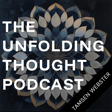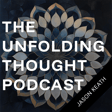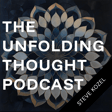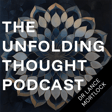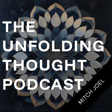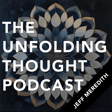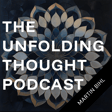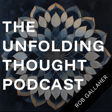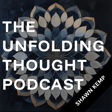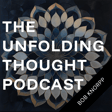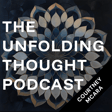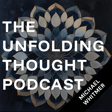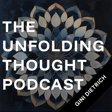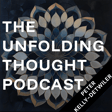Introduction to the Podcast and Guest
00:00:03
Speaker
Welcome to the Unfolding Thought Podcast. My name is Eric Pradham. When you think about the architecture around you, what comes to mind? My guest today, Deaver, believes that architecture goes far beyond just structures and that a big part of architecture is about envisioning a compelling future.
Jess Deaver's Approach to Architecture and Storytelling
00:00:22
Speaker
Jess is an architect, filmmaker, writer, and public speaker whose passion lies in making architecture accessible and exciting to everyone using storytelling and even science fiction to help people envision and shape the future.
Meeting and Recent Conference Session
00:00:38
Speaker
As you'll hear, I found Jess to be fascinating right from the start, and I hope that you do too. And now, I bring you Jess Deaver. Jess, I'm really excited to have you here today. So thank you for joining
Architecture of Sci-Fi and Storytelling Transition
00:00:54
Speaker
We met at an event that centered on the future of Houston and the exercise there for anyone that's interested was centered around or focused on what Houston might look like in the year 2136.
00:01:12
Speaker
And then, you know, in addition to, of course, talking to you and and finding that really interesting, I was able to catch a little bit of a session that you gave at the American Institute of Architects conference in Houston. I think it was two days later and your session was something along the lines of,
00:01:35
Speaker
the architecture of sci-fi. And that was really, really fascinating. So I'm excited to have you here today. And yet there's a lot that I don't know about you and your background. So with that bit of preamble, can you tell me a little bit about yourself,
Jess's Passion for Writing and Storytelling
00:01:52
Speaker
Well, sure. Well, thanks for having me, Eric. This is, it's an exciting time, I think, in my life and my career right now. My name is Jess Deaver. I'm a registered architect in Texas, based in Houston. And I'm architect, a writer, a public speaker, and a filmmaker.
00:02:11
Speaker
i have a rather creative background. I started out in film and television and theater when I was first going to college and and getting involved in storytelling from the performance and the technical capture side.
00:02:27
Speaker
So working with technical cameras and getting really interested in what what it means to tell a very visual or story, whether that's through performance or through ah the camera.
00:02:40
Speaker
And I did that traveling all over the place. I did work in New York. I did work in Austin. and And I really loved it. it was I was working with specialty cameras for a while, so I was doing some some rather cool rigs, you know, helicopter aerial rigs. This was back when we had celluloid film cameras, things were heavy. It it was ah it was interesting.
00:03:01
Speaker
Many stories from that, but The interesting thing was I i have always been a writer as a part of my storytelling process. And the thing i I think that really drew me to the writing side was the ability to craft and curate a story.
Collaboration with Her Father and Love for Architecture
00:03:21
Speaker
So it was the way that we can express the experience of life and someone else's experience of life and then relate it to these interdisciplinary concepts.
00:03:33
Speaker
Now, this word is going to come back a little bit more as we talk because what ended up happening was At some point, I was working in New York, and I i just thought, i feel like I've reached a place where I'm not experiencing film the same way as I used to. It doesn't hold the same level of excitement. And I i wanted something more.
00:03:55
Speaker
And so I decided to go back to Texas from New York, and i worked with my father, who is a and award-winning, amazing architect in Austin. And Immediately upon working with him, we did a film together called Mirror House, which was a super fun collaboration that we did.
00:04:12
Speaker
And i was telling the story of a house that he had designed for a couple who were displaced by Hurricane Katrina. And the home that they were building really reflected a lot of the things that they missed and loved and remembered from their home in New Orleans.
00:04:31
Speaker
And it also reflected a piece of who they were. And I took that opportunity to tell a story about them. i had a i i had it the the film scored by a local jazz trio, and they wrote a ah jazzy New Orleans-style song for it.
00:04:48
Speaker
And it it came out, I think, I look at it now, and obviously technology has changed and it feels ah rugged, but i I adore it so much because I think it's one a ah very honest exploration of what it means to experience space.
00:05:04
Speaker
ah From that, I kind of just immediately fell in love with architecture. and I've always been around architecture. As I said, my father's an architect. But I think what i realized working with him and collaborating with him is that it is such a broad field.
00:05:25
Speaker
It is something that is so encompassing of so many different things. And that really spoke to my interdisciplinary perspective, my wanting to create a vision of my artistic world as something that was enlarging, not
Educational Journey and Impact of Houston
00:05:39
Speaker
So that that enlarging took on the role of, okay, I said to myself, I have to now go to the full extent of what this is. I need to discover everything there is about architecture.
00:05:53
Speaker
And so I immediately enrolled in a master's program and was accepted into the University of Houston. And that was my first exposure to the city of Houston. I went there and was, as many people are, awed by the multicultural aspects of the city and the beauty and and integral nature inside of that industrial space.
Return to Houston and Focus on Accessibility
00:06:19
Speaker
You have a city that is so industrial and so, in a lot of ways, hard. There's a lot of hard surfaces. We talk a lot about apartments. paving and what it's done to the bayou systems there.
00:06:31
Speaker
And yet the bayous thrive. And yet we have these incredible ecological systems. You'll see ospreys on the bayou standing around next to oil pipes that are running underground and kind of exposed from erosion. It's a really...
00:06:47
Speaker
city It's a city that really celebrates the interplay between those two things. And I think that that fascination has continued in my life for for well over a decade.
00:06:59
Speaker
So finishing my degree there, I, you know, as a big explorer of the world... I studied in Austria and then living there for some time, traveled throughout Europe, made it back to the U.S. to finish my degree, and then wound up in Los Angeles working with Norman Pfeiffer, formerly of Hardy Holtzman Pfeiffer.
00:07:20
Speaker
Norman had his firm in Los Angeles. At the time, it was Pfeiffer Partners Architects. And I got to experience working on some really exciting large-scale projects, things like theaters and libraries, academic spaces.
00:07:36
Speaker
And that kind of gave me a new perspective on it. So then something really tragic happened called Hurricane Harvey. And i was living out in l L.A. when Hurricane Harvey hit, and i i had i had a whole week of not knowing what to do about this. And that that moment inspired two things. One, i knew that despite the short period of time I had been in Los Angeles and my desire to stay there, which I absolutely still love Los Angeles so deeply, that city has a part of my heart forever.
00:08:12
Speaker
I knew that I had to come back to Texas. I knew that I had to come back to Houston specifically. And when I came back, the second interesting thing that happened was that I began working with my father.
00:08:28
Speaker
That opportunity coincided with him needing someone to help him out in his office again. And so the two of us embarked on a journey of not just becoming architectural colleagues and design partners, but in us sort of rediscovering the art inside of our architecture and trying to develop a language together to talk about architecture to a broader audience.
Mission to Make Architecture Accessible
00:08:55
Speaker
this is all leading up to My real passion. So this passion I have for being able to talk about architecture, but to non-architects.
00:09:06
Speaker
A lot of times when we hear of or see architects, they are but seen as sort of aloof or they are seen as they have all these big words we don't know. And even today I got a text from someone and they said, Jess will know this word. It's an architect-y word, you know, and I was like, oh, no,
00:09:24
Speaker
You know, those are that that always gets me because i I think architects should be so approachable and accessible because everything we do is for you. we Everything we do is for the public, whether it's a ah private residence or whether it's a large-scale public-urban interface.
00:09:41
Speaker
And so i i began thinking to myself about the future of architecture. and you know, how can we create a future for architecture that allows us to reach the public better and create more of a dialogue?
00:09:56
Speaker
And it was around this time I started reading science fiction ah more heavily so that I could rediscover the way that writers are thinking about the future.
Future Thinking in Architecture
00:10:06
Speaker
And and I think that sort of independent...
00:10:10
Speaker
research is what led me to the talk at the Texas Society of Architects, which is our local our regional AIA group. And that sort of sparked a great many things. I spoke at South by Southwest this year as well, the International Tech Conference in Austin.
00:10:27
Speaker
And I did a presentation called Brave New City, talking about the research there. I so i taught a graduate architecture studio in at Texas Tech University in Lubbock, which for anyone that doesn't know the scale or size of Texas, that's about seven hours away driving from from Houston, or eight hours maybe.
00:10:47
Speaker
And so it's kind of, it it led to a lot of deeper consideration of how we can use science fiction as a method to talk about architecture and and thus not only reach the public in a language that they understand,
00:11:01
Speaker
but inspire the public to begin imagining more beautiful, exciting, resilient futures that are positive instead of these this barrage of the dystopia, which is which is unfortunately becoming very normal.
Communicating Architecture's Importance
00:11:15
Speaker
I feel like there was a through line of some sort in some of the things that you were talking about that comes back to when you design a building, it is, or public space or whatever it is, it is likely to last for decades.
00:11:35
Speaker
It could be longer. And so you are influencing the future of people. you know, of culture potentially. So is there a way with you desiring to speak to the public about architecture to help the public or a non-architect understand it?
00:11:57
Speaker
is Is there a way that you see that you are able to help the average person, if I can say that, understand the impact of architecture and the possibility of architecture for the future of themselves or their community.
00:12:14
Speaker
Absolutely. that you've hit you You've really hit on something there because architects are natural sci-fi thinkers. And they don't think of themselves that way always. But like the event that we did where we met last year, that event thinking 130 the future,
00:12:33
Speaker
is it it may seem to the public intriguing or exciting or interesting. And to architects, it may seem absurd or ridiculous or unnecessary because we're trained in architecture schools in our education to think about the future, but only so far.
00:12:54
Speaker
and And then we get out and we get into practice. And as we begin practicing our in our field, we're faced with these other hot-button words like sustainability and regeneration.
00:13:06
Speaker
And all of these words are really a way of saying, hey, architect, are you thinking further down the timeline of the future of your design?
00:13:18
Speaker
And I think because of that, there's this distance between this understanding. There's this It's almost like two synapses that should be connected that for some reason are not. And architects, I think, are perfectly positioned to be able to work with the public and guide them in seeing the future in this positive way.
Overcoming Constraints in Design
00:13:38
Speaker
Because any architect that's designing, let's say but's say I'm designing a ah a civic theater, like a ah theater for a college, and let's say. And I'm thinking about the lifespan of the college in terms of this college theater is going to be good for another 20, 30 years.
00:13:57
Speaker
um It's going to be great. And then they'll probably need to renovate it or build something that suits their needs at that point. Well, the dean and the public are thinking, I need i need the legacy of my of my college to be 100 years old.
00:14:13
Speaker
200. I want this college to be here always. And so we need to meet in the middle and realize that we need to dream not just bigger.
00:14:24
Speaker
Bigger is one way to think of it. We need to dream longer. And it's about that timeline extending and thinking about what the timeline will look like and what the value of our buildings and our spaces will be as we change as a society.
00:14:39
Speaker
I think I have heard you say, I believe, two things so far. And one is, i believe I hear you saying that there is a greater need for architects to think longer term than sometimes they do.
00:14:57
Speaker
and Though I don't think we've hit on it as much, I think it must clearly come into your talking about or explaining architecture to the general public that we risk losing the nuance or the magic, even the wonder that could come along with the built world if we just flatten things down to, well, architects just draw things on paper, you know, and it's things are just built to follow a plan with no vision whatsoever or no purpose beyond
00:15:37
Speaker
House must be built. Theater must be built. But there is ah lot more that goes into not just planning a space, but also from the architect's perspective, there can be and should be more vision to the work that architects did Yeah, I think I'm a big words person since I'm a writer as well. And wonder is such a great word because it it implies a set a little bit of awe, which is that fear and excitement mixed together.
00:16:09
Speaker
And i do think that there is a bit of wonder that gets lost when, you know, for architects and for, you know, our stakeholders and for the public, for for users of architecture.
00:16:21
Speaker
I think we do lose a little bit of wonder because cost and efficiency kind of take that away. um They have a way of limiting as opposed to enlarging. And I think if we were to realize the power that we have as designers to to inspire that wonder despite the limitations,
00:16:45
Speaker
sort of even with the limitations, then that is where you'll find our ability to change the future. And I don't say that lightly.
00:16:56
Speaker
The architecture that gets built is largely impacted by the way that we are able to envision it. And so that envisioning, like, where does that come from? When you said vision, where does that come from?
00:17:11
Speaker
It comes from our ability to inspire that wonder about that project, about that city, about that country, whatever it may mean. um i i say all the time that for a city to be a great city, it needs the lore.
00:17:27
Speaker
It needs lore, L-U-R-E, and it also needs lore, L-O-R-E. And those two things will make a great city. One implies a level of of pulling, a level of drawing you in, and the other word implies a mystery.
00:17:45
Speaker
And I think those two qualities are present in every single great city you've ever experienced or seen or heard of. And those things are there not because someone in a marketing department put it together.
00:17:58
Speaker
They're not there because the city hall said, all right, everybody, let's create a lure and a lure. We're good. It's there because of the spaces that exist and the stories we told about them.
00:18:11
Speaker
Now, those are two parts. Those go hand in hand. And so the way that we talk about our are cities, the way we talk about our even our homes, these things are really important. And when you think about some of the greatest designs that were ever realized, some of the greatest art that's ever been realized were done under constraint.
00:18:31
Speaker
So constraints have the, you know, whether they're budgetary or time-wise, they have the ability to create something incredible and unimaginably powerful despite the constraint and sort of because of it in a way.
00:18:46
Speaker
You're reminding me how much wonder can be created when you don't just have sort of the sky's the limit, but rather in the case of architecture, for example, you have a certain footprint or you have a specific use case or both, and you have to work within that. But if it's a theater, what are people going to be able to do in this space for the next 30 years because of what you make possible within those constraints.
00:19:17
Speaker
Absolutely. The, you know, the the list is is infinite of how many times I couldn't even pick a single example of how many times limitations have created something majestic.
00:19:31
Speaker
From my own my own, in my own experience, I worked on a house with my father recently. We just finished for our clients and it was because of the constraints in the codes, building codes in Austin, you're not allowed to have your ceiling pitched to a certain height.
00:19:46
Speaker
Now, we had a design for a roof and and a living room in in this living room space that was going to be at a certain pitch that we wanted. And it would have gone, it would have created too high of a ceiling for that code.
00:20:01
Speaker
And so we had to do what was called a tray ceiling. We had to put in a flat portion to that ceiling, which we decided we did not like. It it was very, very unattractive in our design.
00:20:12
Speaker
And so that constraint of that code, which is there, I'm sure, for a very excellent reason for a lot of architecture, it it was very limiting to us. And it led to the creation of what we call the eclipse.
00:20:28
Speaker
And so if you've ever seen a James Turrell opening or Oculus, any of his projects, where you're framing the sky through a hole in the architecture to be able to see the sky separate or differently, it's we did the opposite. So we created skylights above a dropped ceiling that is acting as an eclipse.
00:20:49
Speaker
And so the light spills out from around it. So when you look at the ceiling, you're looking at a floating object like like a moon that's going to obscure the light. But now you're noticing the pitch of these ceiling walls.
00:21:02
Speaker
And as it's going up, it's really creating something I've not seen before. And so that kind of excitement and wonder when you walk into that home, and and this is not a large, expansive mansion home. This is a infill city lot that's 50 foot by 100 foot or something of that nature.
00:21:23
Speaker
And it's a rather, it's a historic neighborhood, and it's a brand new modern house in the scale and language of historic houses, but with this utterly modern eclipse in this main space.
00:21:37
Speaker
So the reveal of it as you walk in, you hear everyone who comes in, they go, They have this sort of exclamation of of interest and excitement. And that wonder would would not have been possible if they had said, you know what, go right ahead. Do whatever height you want in there.
00:21:54
Speaker
And so I like to think about examples like that because the constraint itself does not preclude you. It should be
Evolving Career and Collaboration with Clients
00:22:02
Speaker
helping you. And if it's not helping you, then you're not thinking in that, you're not in that creative zone yet enough That's going to allow you to reach the full potential, not just of your own creativity, but the full potential of the project you're working on.
00:22:16
Speaker
And that applies not just to architecture. That applies to J.J. Abrams. That applies to Ryan Coogler. That that that applies to writers like Stephen King. like It applies to anyone who's in the service of creativity.
00:22:29
Speaker
And sort of shift a little bit, I recently decided that I wanted to enlarge myself as an architect. And I have been working in the residential side of architecture for with my father for about 10 years.
00:22:43
Speaker
And I decided I wanted to go on and adventure. And try to expand and enlarge my work but by coming to work with Fernando Bravais at Bravais Architecture in Houston.
00:22:57
Speaker
And this brought me back to Houston, which I'm very excited about. So I'm getting the chance to live in Houston again. But it's also allowing me to do more public work. They are they work on projects with mission driven clients.
00:23:12
Speaker
And so they're they're working with clients who see design as a tool to be able to realize their mission and their their goals. And a lot of our work is community based or it has resonance with the community.
00:23:24
Speaker
We work with clients on public, a lot of public work. And it's, I think it's thrilling to be at a completely different scale and also working with other architects in ah in our firm that are expanding my thought process and changing how I think about design.
00:23:41
Speaker
And so I think this brings up a really good word we should talk about today. which is one of my one of my favorite things about about being an artist, or I should say about being a free creative in the world, is this idea of being unafraid of entropy.
00:23:58
Speaker
So entropy is like it' a scientific word for really for chaos, for failure of systems into chaos. And i I absolutely love this word because I think entropy is a very positive thing because it makes room for growth and change.
00:24:16
Speaker
And that's something that I try to apply into myself. So as I was working in the film industry, I felt that I needed something more, not just different, but more. I needed to grow.
00:24:29
Speaker
And so by going into architecture, I did not leave the film industry behind. In fact, I've made more films as an architect than I ever did independently when I was when i was working full-time in film.
00:24:40
Speaker
And so I went from treating the film as a technical tool and helping others realize their stories to writing my own and creating my own film stories now that I was an architect.
00:24:52
Speaker
And so that now, working as a residential architect on this smaller scale work, that's very personal, very meaningful, very deep with these clients, I would take that and I thought to myself, how do I want to keep doing this, but i want I want to work on projects that are a little bit bigger.
00:25:10
Speaker
Now, how do I do that? And so I thought, well, I need to go and work with other architects to do collaborative work where we're growing and we're doing bigger scales. So coming to work with Bravay has been an absolutely thrilling experience, but it doesn't mean that I've left behind the small-scale work that I was doing before.
00:25:31
Speaker
And in fact, it feels as though it's a natural piece of that in that entropy because I've introduced a level of chaos into the creative system that I'm working within.
00:25:44
Speaker
And so instead of saying, you know, a lot of people think of our our professional careers, you as a ladder. And you're going to climb this ladder by building rung upon rung to get from one place to the next until you're very high up. And then they have all these other adorable metaphors of like pulling people up with you and all these other things, creating new ladders, all this.
00:26:06
Speaker
I I don't even understand that metaphor because it doesn't work for me. i I think of our professional journey as this odyssey that we're on and that we have a responsibility to ourselves as well as the world. And so the responsibility to ourselves is that we need to be continually growing And that with that growth, we are not leaving something behind.
00:26:30
Speaker
We are not abandoning some level of progress we thought we had achieved. We are simply expanding. And we are taking that and like nomads, putting it into our pack and saying, okay, now I have that extra tool.
00:26:44
Speaker
I have that filmmaker tool. I have that theater tool. I was an actor when I was young. have that actor tool now. And all these things come out and they begin to build. And they every time you introduce chaos into that system and you say, hey, you're too comfortable, Jess.
00:27:01
Speaker
Hey, you need to change it up. What's going on? You've done a lot of the same stuff. What's going on? Now you can go, hey, i'm gonna I'm going to bring in some entropy. i'm gonna make I'm going to make some changes that require me to be more inventive.
00:27:16
Speaker
and to that require me to seek out that wonder in a whole nother scale or a whole nother field or or simply in a whole nother city.
00:27:26
Speaker
You know, there is nothing wrong with saying, I just need to shift gears and go to a different city and do maybe the same scale of work or the same practice of work. um and And all of that can just shake up how you're thinking creatively and how you're experiencing life.
00:27:44
Speaker
When you're working to help the general public understand architecture or explaining aspects of architecture to non-architects, it seems to me like a valuable process for you to try to take that group through or that individual through is for them to not look at architecture as something that is separate from them or the things that they already know and instead
00:28:24
Speaker
to Yes, learn certain facts and new words and whatever else, but also to try to relate some of the things that you're sharing to what they already know so that an individual can see architecture through their own unique lens.
00:28:41
Speaker
Absolutely. it's It's relational. So it's when you're speaking to someone who's every single person, and I'll say this, every single person is an expert at architecture.
00:28:52
Speaker
And I say that very seriously because we've all experienced architecture. And so going back to what makes a great city. People know what a great city is because they know either what it's like to live in a not great city, so they know what the opposite of that might look like, or they have been or visited or lived in a great city or a great place. I shouldn't even say city. These can be any kind of space, whether it's a town or or village. It's a place. It's a community.
00:29:20
Speaker
And whenever we think about talking to the public or talking with non-architects, It's important to, for designers, to always realize that they have an incredible expertise as to what they have experienced or what they desire to experience.
00:29:38
Speaker
And it's not our job as architects to give them great architecture. It is our job to explore their needs and And to explore the site and then to discover together as co-designers of this new place what the future of this place will look like because they will be begin they will be the stewards.
Influence of Public Perception and Storytelling
00:30:02
Speaker
When architects complete their work, we leave. And when the person who we've we've created this design for, they exist within this space, whether they're the dean of the college and they take care of the they take care of the location, the academic building or the library, or whether it's a couple whose home they now have that they live in every day, these spaces are incredibly important. They're impactful in across a multitude of experiences.
00:30:31
Speaker
and And they become the stewards of that architecture. but also of that story. And so the way that they talk about their architect and their architecture is is sort of through the lens of their experience with us through the design process.
00:30:48
Speaker
And that's why it's so important to be collaborative when you work with your client and not prescriptive. Oh, you said you needed a student activity center. Great. I will give you all the components of a student activity center.
00:31:02
Speaker
No, no. I want to know what's the greatest student activity center you've ever been in. What's the one that you wish you could have? Now talk to me about what you want to experience when you walk in there.
00:31:14
Speaker
What does the light feel like? What is the temperature? And these are the things that lead to these deep, wonderful conversations with your stakeholders, with the public. And everyone knows what it feels like.
00:31:27
Speaker
You know, I always say to myself, the impact of cinema and and television on the built environment is is incredible. Because when you think of, for instance, you may not live in a mansion.
00:31:42
Speaker
So when I say to you, think of an opulent mansion, you will begin envisioning mansions you have seen in film and television. You are not envisioning the one down the street because you maybe haven't gone into that one.
00:31:55
Speaker
And so these are the things that begin to inform and create the stories of how we see our own environment. So if I want an opulent house, I'm Now I'm thinking of things I've seen in film and television, and um and I want to apply them like a lacquer to my house.
00:32:11
Speaker
And that may not work. And so it it's almost like there's this awesome opportunity for architects to be filmmaking and archiving their architecture in a way through video, not through just talking head documentary, I'm the architect and I did XYZ, but but through the spatial, experiential, ah storytell visual storytelling, so that now the public has a video archive. They have a library of videos that they can see what great architecture looks like.
00:32:45
Speaker
And it's not being driven by a fantastical storyline. It's being driven by the reality that's being created all around them. And that that, in turn, makes it very possible.
00:32:57
Speaker
And the possibility is something that's attainable. And when things are attainable, you know, we're going to start having greater and greater spaces created. Nowadays, or in the near future, how are you going about explaining or talking about architecture to non-architects? We've already talked about you giving certain presentations.
00:33:22
Speaker
And so whether that's continuing or you mentioned writing, and I think I recall in a prior conversation That you had told me about a couple of forms of writing that you have done in the past. I'm not certain about this, but I think maybe you had written articles that I suspect were not as creative per se as writing a science fiction story.
00:33:46
Speaker
But I think you also told me about writing science fiction, maybe, but regardless, now or in the near future, how are you going about explaining or talking about architecture to non-architects?
00:34:00
Speaker
I am looking at several different opportunities. You know, I've been writing a long time. I've been writing since I was in film, before I was in film, really. And i think the storytelling doesn't change, whether you're a journalist and you're writing a journalistic story or whether you're writing science fiction, which is fantastical.
00:34:20
Speaker
um And I'll say that because the language you use is going to be, it's going to be, it's it's always through your lens. So whether you're, like if you're crafting a journalistic story, I write for Texas Architect Magazine. I also write for Architects Newspaper, which is based in New York.
00:34:37
Speaker
I've written in the past for Connections Magazine. and And these things, these stories you may think, oh, as a journalist, you're not really putting your own spin on things. you're not putting your own lens on things.
00:34:50
Speaker
But the reality is the people that I choose to interview is going to affect the way the story is told. The order that I put those interviews in the story, the ones the the actual quotes that I select.
00:35:06
Speaker
So all of these things are crafting a story that has a beginning, middle, and end. um And And the things that you, even the topics that you choose to write about or your editor asks you to write about, unless you're doing something incredibly dry.
00:35:21
Speaker
But if you're doing more essay-driven journalism, i would say it it involves a ah large amount of storytelling and craft. For me, I love writing science fiction because I think it allows me to explore new worlds.
00:35:36
Speaker
And that's something i'm I find very thrilling. But I've been thinking a lot lately about how I can share those worlds that I'm envisioning with the world, with a larger world.
00:35:48
Speaker
And I've got some ideas. They are percolating. But one of them is this idea of immersive storytelling. So when you, for instance, experience, there are a lot of stories that you can read, audiobooks that you can that you can check out from local libraries that are what they call graphic audio or they're immersive audio. So they have sound effects in Foley and they tell stories. So when you're listening to the story, you're able to imagine the sound of the waves in the background of the ocean or you're hearing the crunching of pebbles or leaves as they're walking through a forest.
00:36:25
Speaker
and so these And you could even have different actors using different voices for the characters. And and those types of things are much more challenging to produce, but they are they are a little bit more accessible.
00:36:39
Speaker
i think I do not know this ah the statistics, but more and more people are listening to audiobooks every day because our lives are getting faster and we're also becoming expert multitaskers.
00:36:51
Speaker
um And we're also looking to escape a lot in our lives. As our lives become more technological, we're integrating that technology into our everyday experience.
Future Narratives and Positive Visions
00:37:02
Speaker
I think what I'd like to do is expand upon that and find ways to tell architecturally inspired stories in an immersive way and potentially tell them that are so site-specific that being in the site that is inspiring the story, you would get a different experience of the story.
00:37:27
Speaker
I'm exploring that right now, and I think whatever that may look like in the future, it is definitely much more accessible because it's, in a lot of ways, making people want to understand architecture to be able to experience the storyline.
00:37:44
Speaker
And just any time you have, the more you have stories being told about architects and about architecture and the built environment, the more you're going to have these spaces created that are really unique and special because people begin to imagine them.
00:38:01
Speaker
In addition to that, I've been thinking a lot about the craft of storytelling and how a lot of it's been driven by the collective anxieties around climate change and political shifts, capitalism and economy issues and military issues. And these things have been driving a lot of storytelling, especially lately.
00:38:23
Speaker
And I'll tell you why. This is a little bit from my lecture that I gave at TXA. And ah a little bit of that is because of the fact that storytelling itself inherently needs a villain.
00:38:35
Speaker
It inherently needs an antagonist and a hero or a group of heroes. It needs to move the story forward. You have to have something like a challenge to overcome.
00:38:47
Speaker
And so many times the villain is that's selected is the climate or the evil oligarchy or the the city that's dystopic and awful and doing all these things to us.
00:39:02
Speaker
And i would I would not say that that's the easy choice because every story you write is a challenge, is is difficult to write. But it is sort of typical.
00:39:14
Speaker
And if you think back to the last, let's say, 25 science fiction movies or TV shows you've experienced, I can almost guarantee that the villain has been one of those things.
00:39:27
Speaker
And when you be begint when you when you extract that from the question and you say, okay— How can I create a story where dystopia is not like the city or or the environment or the military or the politics are not what is villainizing the character, but I still want it to be in the future?
00:39:50
Speaker
How is that? Who becomes the villain? What is the story? how How does that even, is that interesting? Is the real question. Is that an interesting story anymore? And I would argue it is.
00:40:01
Speaker
And I would argue it is for the very specific point that we've been telling stories for thousands of years. But we've only we've only been in this mode of telling this sort of depressed, dystopic science fiction for several decades.
00:40:19
Speaker
And so I think that if we were to separate that and force ourselves to tell more stories that happen to take place in the future, but that were, let's say, about grief-related,
00:40:32
Speaker
And marriage and romance and all these other very human experiences. If we were able to do that and just happen to set it in the future, we would start to experience the future and think about it differently.
00:40:46
Speaker
There's a great a great example of that that i I like to give. Spaceman in Bohemia was a book written by Jaroslav Kalfar. hope I'm saying that right. that actually became ah ah film on Netflix done with Adam Sandler, of all wild actors and producers, which I think he produced that film. And he did a film called Spaceman.
00:41:08
Speaker
And it is a slow, methodic story, but it and it takes place in the future. He's out in space, and it deals with grief and loss, loneliness as a human being.
00:41:21
Speaker
And it just happens to be that he's in but he's an astronaut he's in space. But the villain of the story is really not like I shouldn't say villain. The driver of the story is not this awful climate or this awful military or this dystopic future. I think in the story, he's actually just going, the astronaut is going into this unknown space simply to explore.
00:41:48
Speaker
And that story always brings me to think we need more of that. We need more of these human stories that happen to take place in the future and so that we can explore the future in safer ways, so we can explore the future in more thoughtful ways and also more positive ways.
00:42:09
Speaker
Jess, where does someone go if they not just want to connect with you, but also want to hear one of these talks or maybe there's not a lot recorded or written down? I don't know, but they want to hear something in the future. Where do we direct people?
00:42:25
Speaker
Okay, so i this year I wrote a story which can be accessed online for free but for Texas Architect Magazine, and that's called The Sci-Fi of Imagination.
00:42:37
Speaker
And that article was about exactly what we're talking about so that architects and how we can use science fiction as a tool to create more resilient, positive futures.
00:42:49
Speaker
And then in partnership with that story in the same in the same magazine issue, i wrote a short science fiction story exemplifying what that might look like. And so that, I think, that's one place to get a little bit more. I have a website, Jess, at jessdeaver.com is my email. You can reach out to me. My website is jessdeaver.com. That's J-E-S-D-E-A-V-E-R. only use one S. I like to be short and abbreviated.
00:43:15
Speaker
And that that has a lot of links my stories. And I'm going to be uploading portions of my South by Southwest talk, a Brave New City, which I gave this year at at South by. um So I'll be uploading portions of that um in the next few weeks.
00:43:32
Speaker
I think the full unedited lecture is actually recorded on the South by website. So you could probably Google my name with South by Southwest. 2025 and you'd probably able to find my Brave New City talk and that would be full audio so you could listen to the audio for that. I've been on a few podcasts. You could find more of my design thinking on Architect Tet but podcast or some of my or talk design. i was recorded on that for some of my design talks.
00:44:01
Speaker
But I would say the Imaginary Worlds podcast recently had a we talked about how to design more utopic futures. And so that was an exciting one, too. So that that's another place you could hear more about what it means to envision the future.
Embracing Change for Growth
00:44:16
Speaker
Thank you. I appreciate that. And before we go, is there anything you want to leave people with words of wisdom, places to go or anything else? Just.
00:44:27
Speaker
My biggest words of wisdom may sound ubiquitous, but I think they should be taken to heart for what they are, is be b unafraid of change.
00:44:41
Speaker
Be fearless in the face of change, because that that change is what's going to make you more resilient, stronger, and more creative,
00:44:52
Speaker
And I think that through being fearless in my in my life, in my career, and also in my creativity, I've evolved into someone I would not have imagined I would be artistically.
00:45:08
Speaker
And that is part of why it's exciting. Life can, in a lot of ways, become a routine of tragedies or a routine of happinesses and tragedies.
00:45:23
Speaker
But for me, I think the more we force ourselves to be the creators of our own story and see ourselves as the hero— and envision what that hero should or shouldn't be doing every day, it becomes less of a chore and more of a thrill when we introduce change into that into that mode of thinking.
00:45:49
Speaker
I'm a big proponent of thinking Every time I feel comfortable with something, making a tweak, because it's it can be very daunting to think, oh, I'm going to change jobs.
00:46:05
Speaker
I'm going to change cities. I'm going to do you know, and which is what I just did. i just ended up doing. Maybe something smaller, right? And some of that can create new processes for you. It can create new synapse for your brain to begin to think.
00:46:22
Speaker
It reminds me of a—I just rewatched an episode of Twin Peaks by David Lynch. Fantastic series. You got to go watch it. And in one scene, the red room scene, he films it backwards.
00:46:36
Speaker
And I remember when I first watched it thinking, how is he filming this backwards? How is that even, what would it take to memorize the language backwards?
00:46:48
Speaker
and then i And then I immediately thought, what an incredible way to think about words. How exciting to think about the way words work. taste the way words sound the way my face feels when I say them and I would never have thought about that if I hadn't watched that scene and and and gotten that experience of of it being backwards so I think definitely be fearless change grow and always bring with you the experiences behind you
00:47:23
Speaker
and So don't feel like changing or shifting or moving is dropping your progress.
Podcast Conclusion and Audience Engagement
00:47:30
Speaker
In fact, it is enlarging you, enlarging your progress and making a deeper, more meaningful human experience of your life.
00:47:39
Speaker
I could not agree more. And that is probably a great place to end. So thank you very much, Jess. I really appreciate you being here. And I hope that everyone that listens to this gets as much value out of it as I have.
00:47:54
Speaker
Thank you so much, Eric. It's been an absolute pleasure. Hey, thank you for listening. I hope you got a lot out of today's conversation. If you enjoyed the episode, please take a moment to rate, review, and subscribe, and please share it with someone you know who'd appreciate this kind of information.
00:48:13
Speaker
If you want to bring this kind of thinking to your own business, check out mine at inboundandagile.com. We specialize in helping leaders with challenges around marketing, communications, and leadership so they can inspire real action in their people and audiences.
00:48:31
Speaker
Thanks again for listening, and I hope you'll come back for future episodes.

